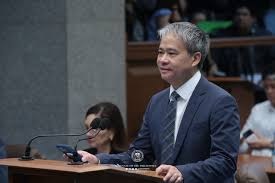MALACAÑANG, PHILIPPINES – A significant controversy has erupted following the sudden surfacing of a “secret decision” made by former Ombudsman Samuel Martires in 2019, which effectively reversed a prior order from his predecessor, Conchita Carpio Morales, to dismiss Senator Joel Villanueva from public office.1 This development has triggered immediate calls from the Presidential Palace, a law professor, and a prominent legislator for a thorough investigation into the matter, raising serious questions about transparency and adherence to legal timelines within the country’s justice system.

Palace Urges Thorough Investigation
The Executive Branch, through Malacañang press officer Claire Castro, publicly urged the current leadership of the Ombudsman’s office, headed by Ombudsman Boying Remulla, to prioritize a deep dive into the 2019 reversal. Castro underscored the potential damage to public confidence that such an undisclosed action could inflict.
“We have faith and trust in the capability of Ombudsman Boying Remulla, and even though they are an independent body, we should still tell them—through us—that this matter truly needs to be thoroughly investigated so that whatever mistakes were made, or whatever laws may have been violated, can be properly addressed and corrected by the Office of the Ombudsman,” Castro stated in Filipino, emphasizing that the alleged non-disclosure, if proven, could severely erode public trust in the nation’s judicial processes.
🕰️ The Timeline Inconsistencies at the Core of the Issue
The controversy centers on the alleged misuse of Priority Development Assistance Fund (PDAF), commonly known as “pork barrel,” by Senator Villanueva during his tenure as a representative of an anti-corruption party-list group.2 The original dismissal order stemmed from a 2008 request by Villanueva for the release of $\text{P10 million}$ from his PDAF for a project later deemed non-existent.
At the House of Representatives, Bicol Saro Rep. Terry Ridon flagged the timeline of the appeal process as the most critical issue. He called on Ombudsman Remulla to “look deeper” into records, citing inconsistencies surrounding when exactly Villanueva filed his motion for reconsideration (MR) against former Ombudsman Morales’ dismissal order.3
Key facts pointing to the inconsistency include:
2016 Filings: News reports from 2016 quoted Villanueva as stating he had filed his MR in November 2016.4 The Senate Journal dated December 5, 2016, also recorded the filing, seemingly within the mandatory 10-day period prescribed by Ombudsman rules.5
Morales’ Acknowledgment: Ombudsman Morales herself acknowledged the existence of the MR in a December 14, 2016, report.6
The Delay: Under the rules, such a motion should ideally be resolved within five days. However, Ridon highlighted that the MR was never resolved by Morales before her retirement on July 26, 2018—a period spanning nearly two years.7
Ridon argued that the delay created an opening for the later reversal: “Had Ombudsman Morales resolved it within that extended timeframe, Ombudsman Martires would not have had the opportunity to act on it much later, on July 31, 2019.”
Conversely, the Congressman argued that if the MR was filed past the required deadline, the dismissal order would have been “final and executory as early as 2016,” meaning Martires would have had “absolutely no discretion to entertain or resolve it in 2019.” The Palace’s Castro echoed this legal point, noting the suspicious two-year gap between the alleged filing in 2016 and the resolution in 2019.
Legal Perspectives and Potential Remedies

The surprise disclosure of the 2019 decision has put the current Ombudsman, Boying Remulla, in a difficult position. On Thursday, Remulla initially stated he would no longer ask the Senate to implement the original dismissal order after the Martires decision surfaced, a ruling that reportedly no one, including then Senate President Vicente “Tito” Sotto III, knew about.
Paolo Tamase, a constitutional law professor at the University of the Philippines Diliman, offered legal context and available recourse.
Transparency vs. Requirement
Tamase clarified that while the Ombudsman is generally not required to publicize the entire document, only informing the involved parties, the highly public nature of Villanueva’s original dismissal order, combined with the “unusual circumstances surrounding the case,” warrants special scrutiny.
Remedies for the Ombudsman
The law professor outlined two main avenues for the current Ombudsman to address the controversy:
-
Supreme Court Intervention: Tamase suggested that the Ombudsman can bring the case to the Supreme Court for intervention if it is proven that the reversal order was indeed executed in secret.
Internal Investigation: A more immediate remedy would be for Remulla to launch an internal investigation to verify the authenticity and procedural integrity of the 2019 reversal order itself.
Tamase concluded that the lack of public availability of the record “may raise fair questions about the authenticity of that 2019 reversal.”
The Defense of Former Ombudsman Martires
In response to the growing public outcry, former Ombudsman Samuel Martires defended his actions in TV interviews on Friday, emphasizing his interpretation of the Ombudsman’s duty regarding public announcements.8
Martires asserted that the Ombudsman is not under any obligation to publicize all decisions, a practice he suggested may have been followed by his predecessors and successors, but not by him.
“It is not the duty of the Ombudsman to be announcing [its decisions] … The reason why I was mum about this was not because I was protecting these people. I was keeping silent because I did not have the right to destroy their future,” Martires stated, implying his decision to keep quiet was rooted in a sense of protecting the reputation of individuals whose guilt has not been definitively determined by a higher court.
However, critics maintain that while privacy for standard cases is understandable, the reversal of a high-profile dismissal order involving a sitting senator—which directly impacts public accountability—demanded transparency, or at least adherence to established procedural timelines.
The convergence of calls from the Palace and Congress, coupled with legal analysis, ensures that the spotlight will remain fixed on the Office of the Ombudsman as it navigates this complicated and sensitive case, which tests the perceived independence and transparency of the nation’s anti-graft body.




